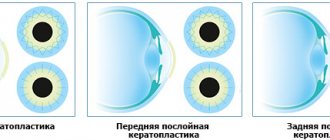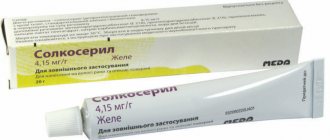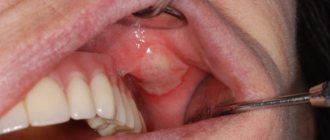Stomatitis is an inflammatory process in the oral cavity, affecting the tissue of the gums, tongue, inner surface of the lips and cheeks. It can occur in adults and children, but is always accompanied by severe feelings of discomfort and pain. Today, pharmacies offer a large selection of medications for the quick and successful treatment of pathology, however, when it comes to the appearance of an illness in children, you want the therapy to be safe.
It is for this purpose that many parents, and even adult patients, use stomatitis talker. The liquid is intended for pain relief, destruction of pathogenic bacteria, stopping the destructive process in tissues, and is suitable for patients of different ages.
Indications for use
In most cases, stomatitis occurs as a result of a viral, fungal or bacterial infection when a foreign agent invades the tissue of the oral mucosa. The situation is aggravated by a significant decrease in immunity; this problem is often observed in children, as a result of frequent colds and infectious diseases. Treatment of the pathology depends on what pathogen caused it.
What should you do first? If an infection is suspected in a young patient, parents should take him to the pediatrician and pediatric dentist. If an adult becomes ill, you should seek help from a therapist and dentist. An experienced specialist will quickly determine the type of pathogen, make the correct diagnosis and select the optimal treatment regimen.
When prescribing mash as the main means of therapy, the doctor will recommend the required composition, taking into account contraindications and possible side effects.
Indications for the use of talker:
- inflammatory process on the surface of the oral mucosa;
- development of puffiness and swelling of tissues;
- the appearance of bad breath;
- bleeding during brushing and rinsing;
- the formation of single or multiple ulcers on the surface of the lips, tongue, cheeks and gums;
- burning, itching and soreness in the mouth;
- temperature increase;
- lack of appetite, weakness (mostly these signs are observed in children);
- dry mucous tissue, which causes a constant desire to drink water.
Nowadays you can prepare many medicines to order.
These symptoms occur at different stages of the disease; it is when they appear that it is recommended to start using the mash for stomatitis. In children, the disease can develop due to insufficient intake of iron, folic acid and B vitamins into the body (here the provoking factor is an unbalanced diet).
In adults, stomatitis can occur as a result of inadequate oral care, concomitant infectious and atrophic gum diseases (gingivitis, periodontitis, periodontal disease), as well as abuse of tobacco and alcoholic beverages.
Features of the treatment of some forms of stomatitis
In addition to the use of antiseptic, analgesic, anti-inflammatory and wound-healing agents, various forms of stomatitis may require the use of other drugs that will act directly on the cause of the disease.
Bacterial stomatitis
For bacterial stomatitis, in addition to general treatment measures, the use of antibacterial agents is most often indicated. Which antibiotics should be taken is decided only by the attending doctor, who prescribes the drug depending on the clinical manifestations, the age of the small patient and examination data.
Candidal or fungal stomatitis
For fungi of the genus Candida, an alkaline environment is destructive, therefore, when treating candidal stomatitis, maximum alkalization of the oral cavity is achieved. In young children, for this purpose, you can use a solution of baking soda (1 teaspoon per small glass of water), which I treat the mucous membranes with twice a day.
In severe cases, the use of antifungal drugs is indicated:
- Candida for the oral cavity is a solution based on clotrimazole. Apply to inflamed areas 2-3 times a day. The course of treatment is 7-10 days, which cannot be interrupted due to the high risk of relapse.
- Nystatin is a drug with a pronounced antifungal effect. It is used in the form of a solution (prepared by dissolving tablets in warm boiled water) or cream. Apply to the affected areas 2 times a day.
- Fluconazole (Fucis) is a tablet form of an antifungal drug that can be used to treat severe forms of candidal stomatitis. In children, the dose is up to 12 mg per kg of body weight per day. The duration of treatment is determined by the severity of the condition.
Infectious (herpetic) stomatitis
Since the cause of the development of herpetic stomatitis is the herpes virus, if it occurs, the child is advised to use antiviral drugs.
- Oxolinic ointment - oxolinum shows high effectiveness against the herpes simplex virus. For herpetic stomatitis, it is necessary to apply the ointment 1-2 times a day to the area of the rash.
- Acyclovir is an antiviral agent. Prescribed to children with severe forms of herpetic stomatitis. The pediatric dosage is 100 mg 5 times a day for 5 days. Intravenous use is possible for infants. Applying 5% ointment or cream to the mucous membranes of a child is undesirable, as this may cause an increase in the inflammatory reaction.
- Viferon is a drug that has antiviral and immunostimulating effects. In pediatric practice, it is used in the form of rectal suppositories (twice a day), or as an ointment for the treatment of herpetic infections of the skin and mucous membranes (applied 2-3 times a day).
Ulcerative stomatitis
Often ulcerative stomatitis appears against the background of other diseases. Therefore, treatment is carried out specifically for the underlying disease. If the cause is poor oral hygiene, then the first step is to teach proper dental care.
If the causes are pathologies of the gastrointestinal tract, endocrine or immune system, then correction of these disorders is necessary.
Local treatment measures will include adequate pain relief, the use of antiseptics to prevent additional infection, and wound-healing medications.
Allergic stomatitis
Treatment of allergic stomatitis comes down to identifying a possible allergen, eliminating its influence and using antihistamines:
- Parlazin is a long-acting antiallergic drop. For children from three months of age to one year, the dosage is 3 potassium 1-2 times a day, over a year - 5 drops.
- Suprastin is an antihistamine that can be used in pediatric practice. Children under one year old can use 10 mg of the drug (a quarter of a tablet). After a year, the dosage is increased to 20 mg (half a tablet) 2 times a day.
At the same time, the child must be provided with hypoallergenic food and avoid contact with household chemicals and pets.
Traumatic stomatitis
In case of traumatic stomatitis, it is necessary to limit the oral cavity as much as possible from the effects of irritating food and food. It is imperative to carry out complete pain relief and use anti-inflammatory and wound-healing agents. If necessary, a course of antibiotics is prescribed.
Composition of the drug
The medicine received its name “chatterbox” for the reason that before use it must be shaken each time in order to thoroughly mix all the components. You can purchase the product at the pharmacy or prepare it yourself at home; there are several recipe options for this.
Composition of the pharmaceutical mash:
- streptocide is a substance belonging to the group of sulfonamide antibiotics;
- Norsulfazole is an antimicrobial drug;
- Anestezin is a component due to which it is possible to achieve an analgesic effect;
- sea buckthorn oil, which has powerful anti-inflammatory and healing properties.
What are the advantages of purchasing a pharmacy version of talker? Firstly, the medicine is manufactured under sterile conditions, which is very important if it is prescribed to a child. Secondly, the components are mixed in the exact recommended dosage, which makes the product safe to use. Thirdly, the shelf life of an open bottle is no longer than 20 days, which forces the baby’s parents to throw out the expired product and not reuse it.
Homeopathic treatment
Many parents prefer to treat their children with homeopathy. However, such treatment should only be auxiliary and complement traditional methods.
In pediatric practice, the following drugs can be used:
- Borax,
- Mercuriussublimatuscorrosives,
- Natrum muriaticum,
- Arsenicum.
The group of homeopathic medicines also includes the combination remedy Malavit, which combines homeopathic components, natural herbal extracts and water from artesian springs. For rinsing with stomatitis, a solution is prepared from 5 drops of the drug and 100 ml of water (children under 5 years old need only one drop per year of life). The procedure is carried out 3-5 times a day after meals.
Homemade recipes
To prepare the product yourself, you must first prepare the necessary medicinal components, a glass container with a tight-fitting lid. The jar or vial must be sterilized in boiling water. The resulting liquid cannot be stored for longer than 3 days, even if kept in the refrigerator - this must be remembered during treatment, especially if the solution is being prepared for children.
Homemade mash recipes:
Ohu for teeth whitening
- You need to take one tablet each of Furacilin, Tetracycline and Streptocide (each of these drugs has its own antiviral, antibacterial and antimicrobial properties). You will also need 1 ampoule of Novocaine in a 10% concentration to achieve an analgesic effect. First you need to crush Tetracycline and Streptocide tablets into a fine powder and add Novocain to them. Separately, the Furacilin tablet is poured with boiling water in an amount of 250 mg and infused for at least two hours. After the time has passed, Furacilin is poured into a container with the remaining components. The container is tightly closed with a lid, the composition is shaken and applied up to 6-8 times during the day.
- The ingredients are a tablet of the antifungal drug Nystatin, a teaspoon of sea buckthorn oil and one ampoule of vitamin B12. The tablet is first crushed to a powder state, then the liquid components – oil and vitamin – are added to the container. After thorough shaking, the composition is used three times a day.
- Ingredients: sea buckthorn oil in the amount of one teaspoon and 1 ampoule of lidocaine (this is an excellent pain reliever) in a 10% concentration. The components are mixed in a sterile container, the solution is shaken, after which it can be used to treat the affected areas of the mucous membrane up to 6-8 times a day.
- Ingredients – sunflower oil (1 tbsp), Methyluracil solution (1 ampoule), Anestezin (1 ampoule), a teaspoon of sea buckthorn oil and the same amount of Shostakovsky balm. The listed components have regenerating, healing, anti-inflammatory and enveloping properties. After mixing and shaking the ingredients, you can use the mash 3-4 times a day.
- Ingredients: chicken protein (necessarily fresh) and 120 ml of boiled, pre-cooled water. The protein is thoroughly beaten in water, after which the affected oral cavity is treated with the composition four times a day; you can also rinse with this solution. Before each use, prepare a new composition and discard the remains of the old one.
Furacilin is an antiseptic that has been proven over the years
When preparing different compositions of mash, you must observe the recommended proportions, sterility and caution.
Table of children's medications against stomatitis by age
| Drug/Age | 1 month | 3 months | 4 months | 5 months | 7 months | 1 year | 2 years | 3 years | 5 years | 6 years | 10 years |
| Paracetamol | + | + | + | + | + | + | + | + | + | + | + |
| Soda | + | + | + | + | + | + | + | + | + | + | + |
| Candide | + | + | + | + | + | + | + | + | + | + | + |
| Viferon | + | + | + | + | + | + | + | + | + | + | + |
| Suprastin | + | + | + | + | + | + | + | + | + | + | + |
| Ibuprofen | — | + | + | + | + | + | + | + | + | + | + |
| Holisal | — | — | + | + | + | + | + | + | + | + | + |
| Kamistad | — | — | + | + | + | + | + | + | + | + | + |
| Parlazin | — | — | + | + | + | + | + | + | + | + | + |
| Kalgel | — | — | — | + | + | + | + | + | + | + | + |
| Chlorhexidine | — | — | — | — | + | + | + | + | + | + | + |
| Furacilin | — | — | — | — | + | + | + | + | + | + | + |
| Iodinol | — | — | — | — | — | + | + | + | + | + | + |
| Vinylin | — | — | — | — | — | + | + | + | + | + | + |
| Malavit | — | — | — | — | — | + | + | + | + | + | + |
| Fduconazole (Futsis) | — | — | — | — | — | + | + | + | + | + | + |
| Ingalipt | — | — | — | — | — | — | + | + | + | + | + |
| Honey | — | — | — | — | — | — | + | + | + | + | + |
| Propolis | — | — | — | — | — | — | + | + | + | + | + |
| Nystatin | — | — | — | — | — | — | + | + | + | + | + |
| Oxolinic ointment | — | — | — | — | — | — | + | + | + | + | + |
| Hexoral | — | — | — | — | — | — | — | + | + | + | + |
| Miramistin | — | — | — | — | — | — | — | + | + | + | + |
| Lugol | — | — | — | — | — | — | — | — | + | + | + |
| Stomatidin | — | — | — | — | — | — | — | — | + | + | + |
| Stomatophyte | — | — | — | — | — | — | — | — | — | + | + |
| Metrogil Denta | — | — | — | — | — | — | — | — | — | + | + |
| Hydrogen peroxide | — | — | — | — | — | — | — | — | — | — | + |
| Chlorophyllite | — | — | — | — | — | — | — | — | — | — | + |
| Aekol | — | — | — | — | — | — | — | — | — | — | + |
How to use
How many times to treat the oral mucosa with different compositions of the mash is already written above. However, general instructions for use still exist. Small children do not know how to rinse their mouths themselves; here it will be enough to treat the surface with cotton wool, sterile gauze or a bandage. Before using the mash, you must first clean the oral cavity of microbial plaque using a solution of potassium permanganate, soda or a decoction of chamomile flowers.
Treatment of mucous membranes with mash should begin 30 minutes after eating. To achieve a lasting result, after applying the composition you should not drink or eat for half an hour. First, the composition must be shaken well in a container, a sterile bandage, a piece of gauze wrapped around a finger, a cotton swab or just a washed finger should be wetted and the oral mucosa with signs of stomatitis should be thoroughly treated. Do not put too much pressure on the tissue to avoid bleeding and pain.
If after a few days of regular and correct use of the mash no positive results are observed, it is recommended to visit the dentist again so that he can conduct a more thorough examination and, possibly, prescribe other methods of therapy.
You cannot consider stomatitis a “common” childhood disease and take it lightly, thinking that it will go away on its own. In addition to the fact that oral ulcers bring a pronounced feeling of discomfort, pathology indicates infection with a fungus, virus or bacteria - and this is already an indication for adequate treatment.
What not to do with stomatitis
Often the older generation, when asked “how to treat your mouth for stomatitis?” Young mothers are advised to use alcohol solutions of brilliant green, blue, or fucorcin. It is believed that such products are good at disinfecting purulent wounds. However, this should not be done, since alcohol causes increased symptoms of inflammation and pain, which will negatively affect the child’s condition.
Another popular remedy against candidal stomatitis is borax in glycerin. The use of this product in childhood is also undesirable, since it contains quite toxic components, an overdose of which can cause significant harm to the baby’s health.
«
In the article we tried to provide the main means and methods of treating stomatitis in children. However, only a doctor can prescribe the correct treatment after examining the child. Delaying a visit to the doctor can cause serious complications and future health problems for the baby.
How many days does treatment last?
Correct, competent treatment of stomatitis significantly speeds up the healing process. Depending on the type of disease, it lasts for 3 to 7 days. If after 1 week of treatment the signs of the disease have not disappeared or worsening is observed, then the patient most likely has complications. The following factors may be the probable reasons for its development.
- The patient self-medicated or did not follow the doctor's instructions.
- Decreased immunity.
- The presence of chronic diseases of the body.
- Regular injury or infection of the oral mucosa.
- Undiagnosed allergy.
- Having bad habits - smoking, chewing, etc.
- Depression or frequent stress.
- Improper oral hygiene.
- Uncontrolled use of medications.
- The use of oral hygiene products containing sodium lauryl sulfate.
Returning to the question - can stomatitis go away on its own - it should be noted that a seemingly harmless disease can turn into serious problems for the patient. Therefore, you should remember three “don’ts” - don’t
engage in self-medication,
do not
put off visiting a specialist and
do not
ignore the recommendations of your doctor.
How to understand that stomatitis has passed?
Very simple! A complete cure is indicated by the absence of lesions in the oral mucosa. There are no small ulcers, wounds or plaque on the cheek, palate, lip, tongue or tonsil area. The mucous membrane looks healthy, is well moisturized, does not cause pain and does not create discomfort during eating, talking, smiling and performing hygiene procedures.
How to distinguish stomatitis from other diseases?
The main sign of stomatitis is the presence of characteristic ulcers, the tissue around which looks healthy. The disease is rarely accompanied by systemic symptoms and, as a rule, recurs from time to time. For a competent specialist, it is not difficult to distinguish stomatitis from other ailments.
For a sore throat
When you have a sore throat, your body temperature always rises. In this case, it is not the ulcers themselves that hurt, but the throat area. Upon visual examination, the tonsils appear swollen, inflamed and red.
For herpes
The problem is that herpetic stomatitis is one of the manifestations of herpes. A viral disease is accompanied by the formation of characteristic blisters that burst and dry out. In the presence of other types of stomatitis, the nature of the ulcers is completely different.
For cancer
Ulcers due to cancer of the oral mucosa do not go away on their own even after treatment. Over time, they increase in size and may bleed and become painful.
From thrush
Candidal stomatitis is thrush caused by the activity of bacteria of the genus Candida. In all other cases, the nature of the disease will be different and can be easily distinguished from thrush by the presence of characteristic ulcers.
For syphilis
When infected with syphilis, a red spot appears on the surface of the mucous membrane. Gradually it thickens, takes the form of a dense nodule and ulcerates - a typical hard chancre is formed, which is completely different from ulcers with stomatitis.










